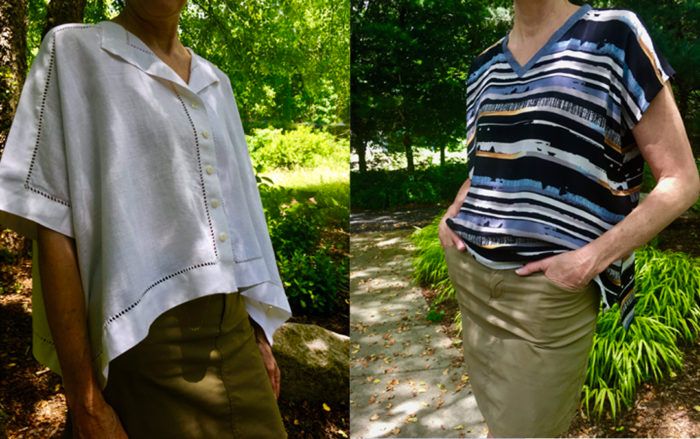
Wearing fabric squares or rectangles is as old as clothing itself. In ancient times, fabric came off the loom and onto the body with few or no manipulations. Togas, bog coats, and kimono are basically rectangles that were turned into garments with a few simple cuts and seams or simply with the addition of a belt.
Fast-forward a couple thousand years, enter my sewing room, and discover why I find it fascinating even today to work with rectangular fabric pieces and whole cloth. As my sewing skill set has grown, I am able to fold and dart and seam fabric into almost any shape I want. Patterns make it even easier to go from flat to 3-D, but I am still drawn to the simple square and seeing how little I can change it and still create a garment.
Experimenting with this idea over the years, I have created some masterpieces and many epic failures. I have learned a lot from both. Let me share some of those insights and maybe persuade you to try some square sewing of your own. You may discover that it’s hip to be square.
Consider the drape, or lack thereof
Humans are not rectangular, so we must make flat fabric conform in some way to our 3-D bodies. The more drape a fabric has, the less we have to do to it to get it to conform. So a square of rayon challis is going to be much more cooperative than a square of cotton drill for creating a minimalist garment.
Knit fabrics often drape nicely, but the stretch has to be managed in different ways when you are using a minimum of seams. I find knits great for garments that will be wrapped as part of the design.
The weight of the fabric isn’t always the best indicator of how much or how little drape it exhibits. Heavy linens can be drapey, while cotton batiste can billow and stand away from the body. I find fabrics with a lot of drape quality create elegant garments.
Proportions can make or break a design
I often run into a lot of “I can’ts” when I talk about square drapey garments, as in: “I can’t wear anything that’s too flowy,” or “I can’t have anything that makes me look bigger on the top (or the bottom, or the side . . . fill in your favorite.) These objections most often are a signal that the garment proportions are not appropriate to the wearer and/or the outfit. Clothing that falls effortlessly over our perceived imperfections is almost always more flattering than garments that have been darted and fitted too enthusiastically.
An easy way for me to think about visually pleasing proportion is to think in thirds. This works on lots of levels. Dresses often look nice hemmed at two-thirds the length from your neck to your shoes. This measurement usually lands somewhere in the knee vicinity. Blocks of color, e.g. pants and top, are pleasing if the pants are two-thirds the length and the top is one-third the length. Color blocking within a garment also looks nice when the principle of thirds is applied.
How does this work with flowy, drapey square tops? The same way. What this means practically is, you’ll want to crop that top. Don’t try to get it to cover your hips or your tummy. Instead, think about making it a pleasing length overall with your outfit. If that is working, the hips and tummy will take care of themselves. Focusing on an overall pleasing proportion will allow you to shine without drawing attention to any one feature.
Try this in front of a mirror
Put on a pair of pants and a different colored top that is about hip length. For most people, this will give a block of color for the top that is about the same length as the block of color for the pants. Now turn up the hem of the top until the proportion has been changed to one-third top to two-thirds pants. Is that better?
One thing to keep in mind with fuller tops is they take up visual space in volume—not just length. So you may need to shorten even more to get the overall one-third/two-thirds visual effect.
Starting with the right fabric and finishing with the right proportion will have you well on the way to a successful top. Here are some examples of simple squares or rectangles that were turned into garments with just a few snips or stitches.
When the weather heats up, there’s nothing better than clothing that touches as little as possible. Here are two examples using silk squares that are super cool.
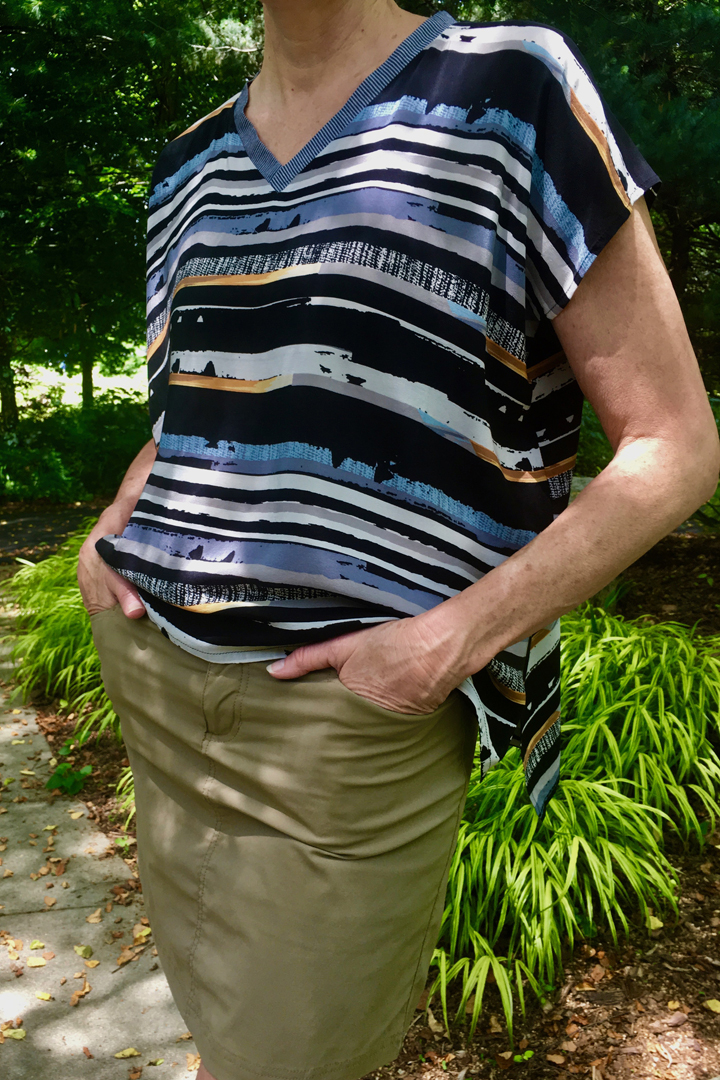
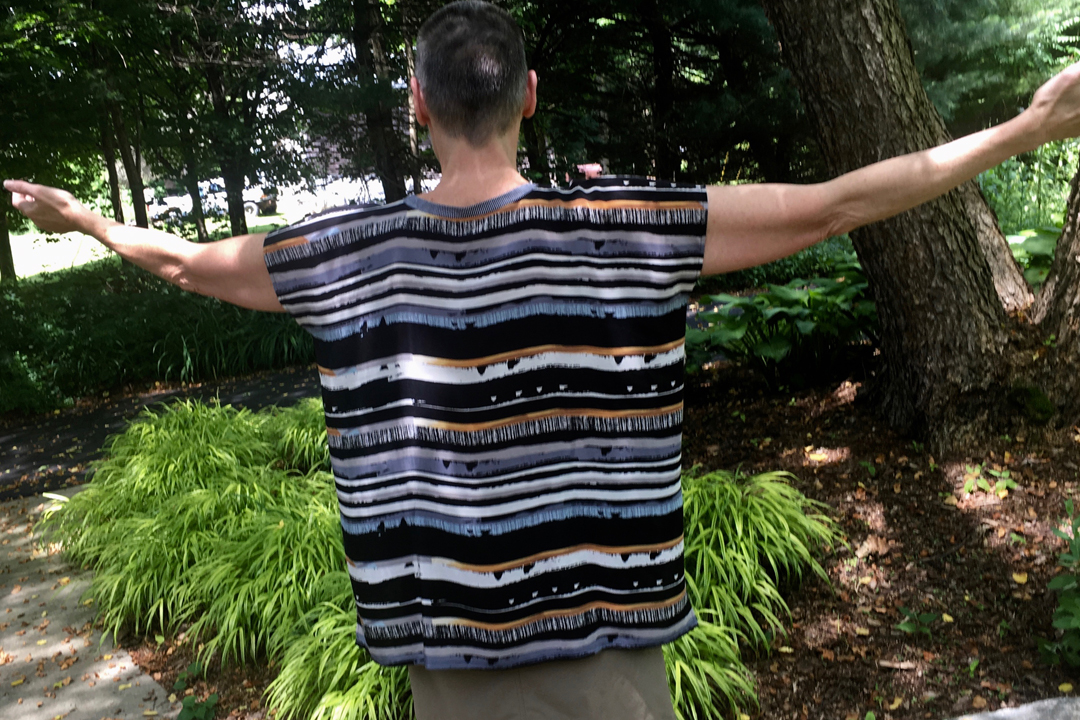
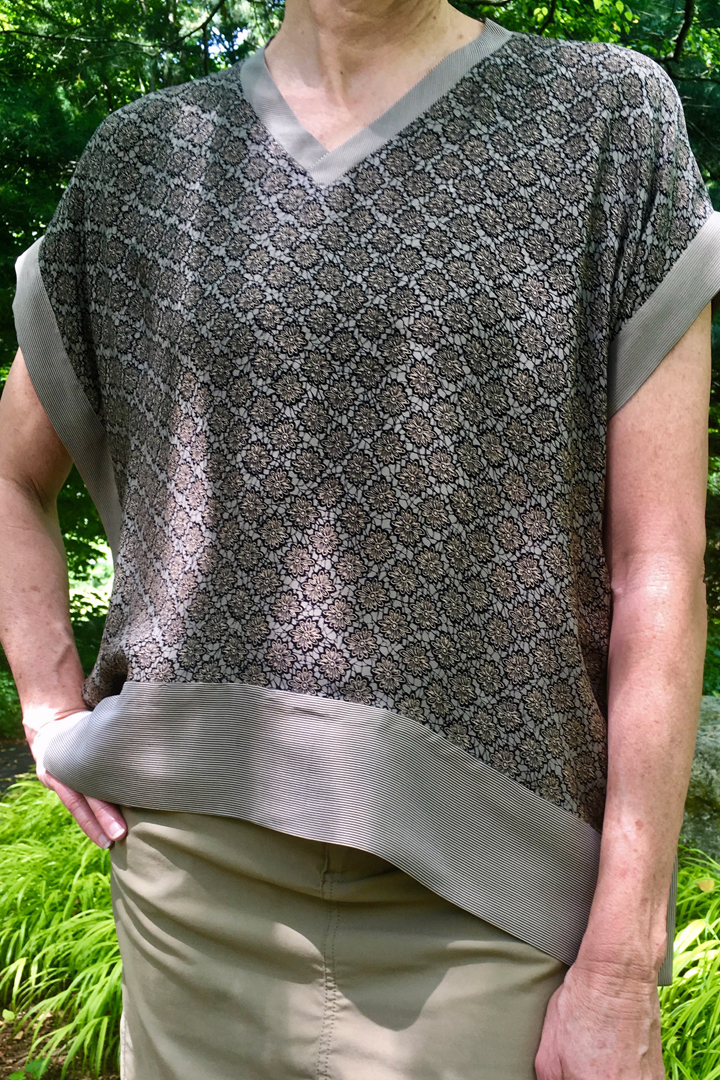
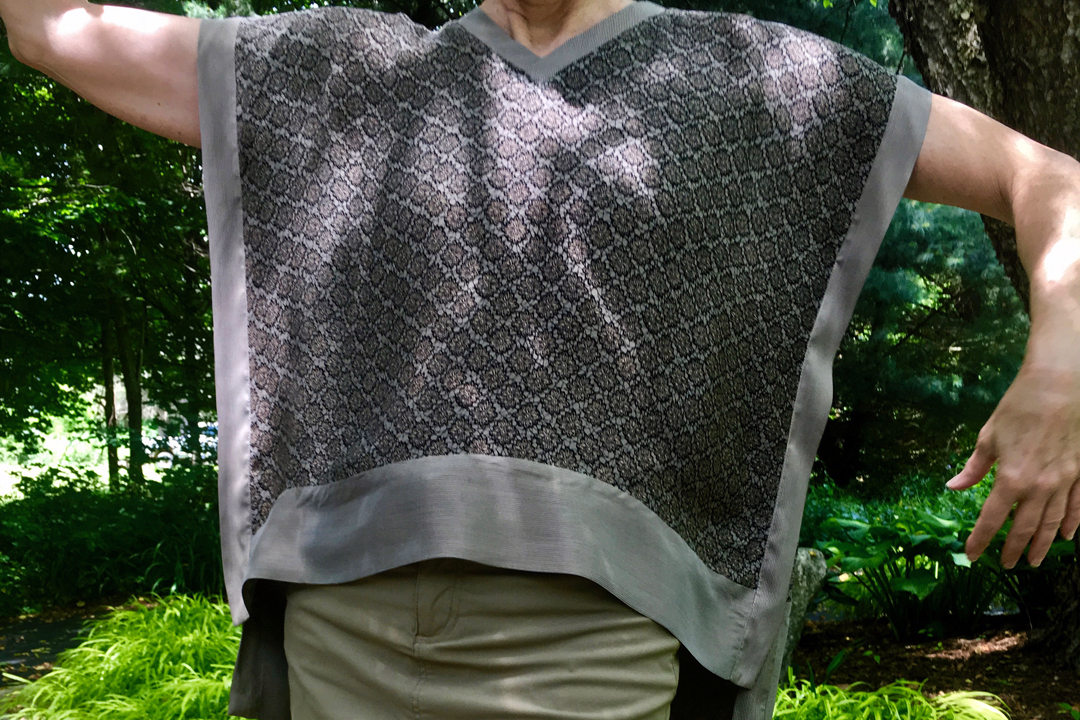
Create a hole for the neck, then add two side seams, and you have a top.
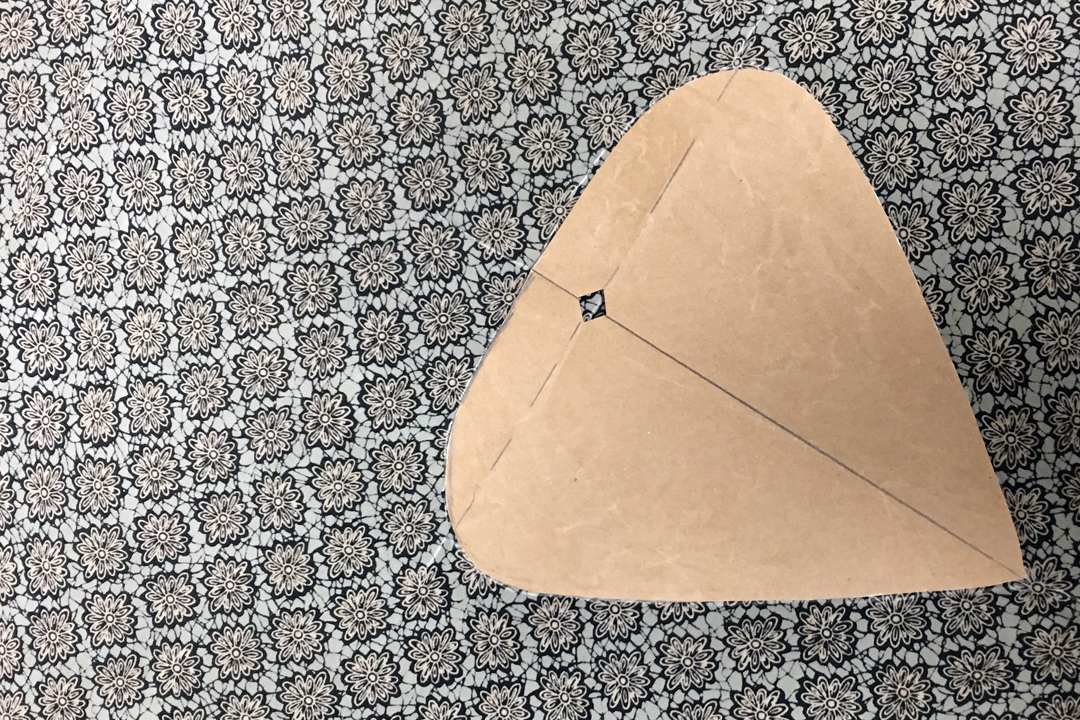

I created another rectangular summer top using four gorgeous linen napkins.
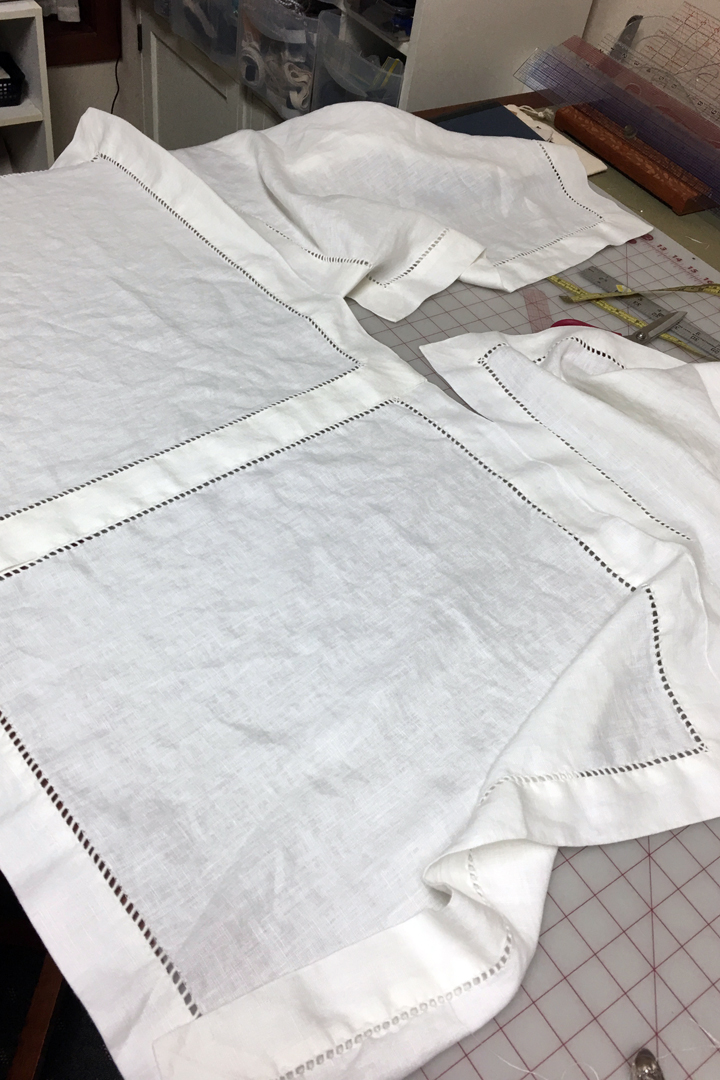
The seams are at the shoulders and center back, while buttons close the front. The only cutting was opening the buttonholes.

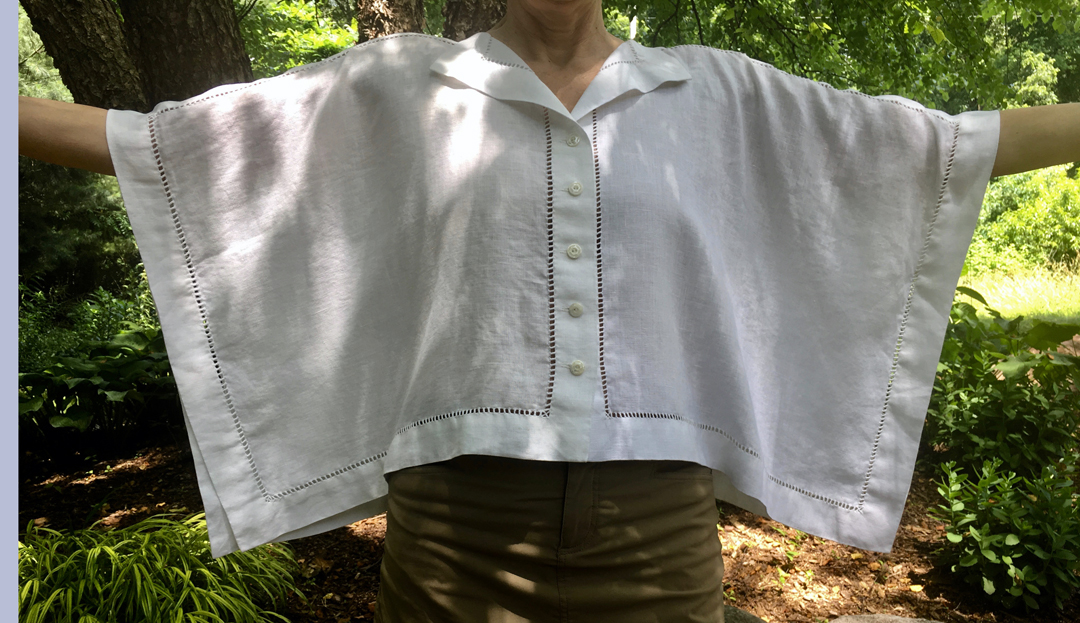
Sometimes, staying “in the box” is the best way to get some out-of-the-box results. The possibilities are endless.
































Love these tops. My favorite is the linen napkin top. Very clever and flattering.
Thanks! I live in these things when the temperatures go up.
Totally agree. It’s very attractive and unique!
It is fun to have something you don't see anywhere else.
Great idea. Have to remember the proportions. I really don't want a bare belly at my age, or another layer of clothing in hot summer weather. The illustrations show that this won't be the case. I am very short and the one third, two thirds will visually lengthen me, I think.
I think anytime you have a visually, balanced, pleasing proportion, you make the most of your particular stature.
Just what I've been looking for. Thanks.
How did you join the underarm edges? at the faggoting? not all the way to the bottom? I'm plus sized and will need to find some really large napkins.
I sewed everything on this one by hand. I slip stitched along the faggoting so the actual edges of the napkins are not connected at the sides. I have found that Pottery Barn has very generously sized napkins and the fabrics are really lovely. You could also add 'partial' napkins if you need a bit more room.
Hi user-1115536. We talked to Becky about your questions, and here's what she said: "I put my napkin top together by hand because the napkins did not have any machine stitches/top stitching that showed, and I wanted to keep that clean finish. I used a slipstitch on the shoulder seams where I was butting the edges. For the underarm seams, I whipstitched through the faggoting to connect the napkins. I had large napkins to start with, so I didn’t need to increase the dimensions. If you can’t find big napkins, you could cut and piece a few together to get bigger squares. Antique dresser scarves are also a good starting point and usually are larger than napkins."
What a creative idea and good looking
So kind...thank you!
Great idea!
Hope you can use it in your sewing room adventures.
Any instructions on how to draft the neck opening above? Thanks!
The opening that is cut is approximately 8" along the center line from the bottom of the "V" to the center of the back neck. And about 8" along the shoulder line, which is 1" from the back of the neck. I will try to attach a picture that might be more helpful. About 1/4" seam allowance is included in this opening to add a ribbed knit neckband. The neckband is about 1" finished. I find if it gets much wider it is hard to get it to ease in and lie flat. The measurement for the neckband depends entirely on the amount of stretch in your fabric. I cut an extra long piece and play around a bit to get the right length.
“[Deleted]”
Thanks for this article. I have been trying to understand proportions and have read several threads articles so far. This one gives examples, which has given me a glimpse of understanding. I am wondering about the type of top that will be in proportion to a wide leg pant hitting around mid calf, such as the Emerson Pants by True Bias. Because of their width, they take up more visual space than traditional straight legged or pegged leg pants, but they are shorter than most of those. What shape and length of top would you recommend, or better yet how would I determine what works best proportionally? I am very interested in learning more about his aspect of design. so that i can concentrate on sewing things that will flatter my body. Thanks for your article and your assistance.
The 1/3 - 2/3 idea has always been my starting point. But as you noted, proportion is about width as well as length. Understanding the visual impact not just the length divisions of an outfit can be key to a successful look. Wide on both the top and bottom, even if they are 1/3 and 2/3's in length may be overwhelming. Color and print also take up differing amounts of visual space, so where they are used can change the look as well. I would probably think about a very cropped style of top if my pants are a mid calf and wider style. I like seeing where my waist goes in if I am wearing wide pants, it keeps me from being swallowed up visually by fabric. I think proportion often gets overlooked as a fashion element and can make such a difference when done well. I applaud your interest and attention to it and hope this helps.
Thank you, Becky F. I appre3ciate your advice and look forward to more articles on understanding proportion in clothing design.
really enjoyed this article, I have a suitcase full of table linens! Was this published in Threads? Can you tell me magazine number please. I have a lot of Threads on hand!